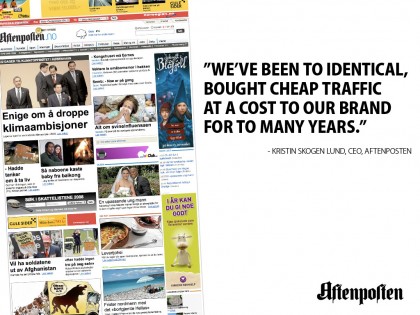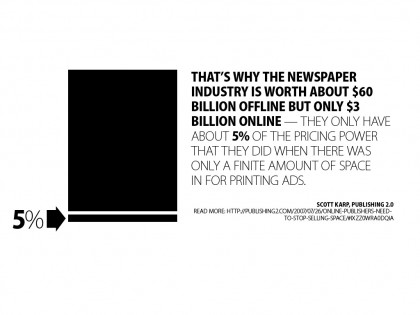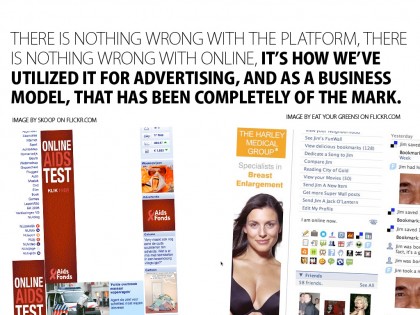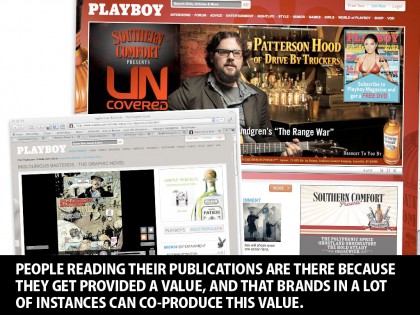Online advertising will change fundamentally during the next year to four years. The reason is more unexpected, and with larger consequences, than anticipated.
I’ve written previously on how both the competition to the online ad product (ie. earned media) and our citizens’ change in online behavior should be forcing online media to innovate its advertising and marketing products. Now it seems these symptoms where only the tip of the iceberg: a change in the fundamental business model of the media industry.
In 2009 media has been failing, and it’s failing fast. All hands are on deck and the ability to think disruptively, not only incrementally, has invited people to rethink the whole structure of their business model. This will affect their income strategies and the companies sponsoring these income strategies.
In other words: online advertising is changing, because the media business model is changing.
This is the case I’m trying to make:
Media has been stuck for some time, but the scalability of the online advertising real estate, and the enormous market has kept the ball rolling. Not sensing that the drive for traffic and the drive for more ad space lessened the editorial product and made the media brands invisible
(about half How to get viagra combination (11) . In addition, patients with possible or.
.
As Kristin Skogen Lund, CEO of Aftenposten, one of the biggest newspapers in Norway said at a talk last week:
- – ”We’ve been to identical, bought cheap traffic at a cost to our brand for to many years.” – Kristin Skogen Lund, CEO, Aftenposten
Scott Karp, editor of the Publishing 2.0 blog ads another argument:
- “most newspaper websites sell SPACE for commodity advertising — display ads and classifieds — and thus are hard pressed to compete with ad networks that specialize in selling commodity ad space by the megaton” – Scott Karp, Publishing 2.0

The result is that the display advertising model works just fine for media buyers, but for brands they are receiving a decreasing amount of effect – and compared with the effect from earned media the investment at times can seem as a complete waste. At the same time media companies have brought a knife to a gunfight, they are competing against the networks, a game they can’t win, and are destroying their most valuable possession – their brand – along the way.
So something has got to change!
An incentive for change:
Two important facts where laid out by Skogen Lund at a conference last week:
– Only 5%
Skogen Lund stated that Aftenposten’s online revenue only represented 5% of their total revenue. Scott Karp confirms this as representative for the whole industry:
- “That’s why the newspaper industry is worth about $60 billion offline but only $3 billion online — they only have about 5% of the pricing power that they did when there was only a finite amount of space in for printing ads.” – Scott Karp, Publishing 2.0

Online advertising in it’s current form is not a big revenue model for media companies, which would incentives innovation. If only one believed that online customers where better customers… Are people worse customers online? Hardly, FEED: The Razorfish Digital Brand Experience Report / 2009 states:
- “Brands that use digital to drive awareness also drives sales: 64% of consumers report making a first purchase from a brand because of a digital experience” – FEED 09
So there is nothing wrong with the platform, there is nothing wrong with online, it’s how we’ve utilized it for advertising, and as a business model, that has been completely of the mark.

– Advertising decreasing, subscriptions increasing
A second interesting fact presented by Skogen Lund was a graph showing how advertising has represented a sharp decline in revenue, while subscriptions a sharp increase this last year. This at the same time as we are seeing niche newspapers, with strong brands and identifiable products, increasing their subscriptions in contrary to the mainstream newspapers which are declining. This tells us that there is an interest in a strong media product, and people are willing to pay for it
.
My conclusion is this:
Media is a product (a membership), has always been a product and will continue to be a product. But somewhere along the way someone found that sponsoring it with advertising was a god idea. (Brilliant video for Norwegian readers to be found here (Thx. Freddy)). Which it was, to some extent. But the consequence was that the drive for traffic became more important than building a strong brand and a unique product.
Today when advertising sponsorship is failing as a business model, media has to start charging for something. But since they are left with a generic product it is impossible to charge for content that can be found for free ten other places.
(which is probably why Murdoch is shutting out Google, and also the argument of Mathias Dophner here. They want to protect it before they create it.)
So I anticipate that blood will continue to flow in the Media industry – because there is not enough money to finance all these institutions, and there is not enough strong brands to charge for their product.
Which leaves us with advertising: Advertising online will change because the media business model will change. Media brands seeing that they either don’t need to garbage their stories with competing stories, as Scott Karp says:
- “advertising isn’t more valuable when placed next to premium content because display advertising has so LITTLE value to begin with. In fact, display advertising creates so little consumer value that it actually SUBTRACTS value from high quality editorial content when placed next it.”
Or because they find that people reading their publications are there because they get provided a value, and that brands in a lot of instances can co-produce this value. That NEW BRANDS are value creators, and that NEW MARKETING IDEAS are about creating additional value – not a competition between the attention of stories. And that this value, and a relationship built on trust between the media, the brand and the participant, will create a new, valuable, membership based content system.

That brands, as Forrester already has anticipated, will sponsor niche arenas where they can build direct relationships with their participants and members. What these arenas are, how large, small, niche or commercial, content, conversation or context based is completely up to our own imagination and creativity.


Media is advertising’s banking business. They mostly don’t care about content, they care about how cheap they are able to sell advertising space. “Function follows form” at its best (definitely the title of my future book about this industry). But our world doesn’t fit to this concept anymore. Thanks god, this is going to end now.
Hi Gerald, thanks for adding your five cent to the conversation.
I think media is as interested as we are in discovering the new ideas, (and taking back ownership of their real estate) but it is the system that is corrupt. Held together by the only role still getting some value back from the status quo.
This quote is from the CEO of the media company I also quoted in the post (my translation):
”We’ve lived of selling generic squares – it’s incredible that we are still aloud to do that, and that we are trying to live of it”
– Kristin Skogen Lund, CEO, Aftenposten
I agree. I think media companies will have to create new revenue streams, to diversify their offering and make it genuinely valuable.
I also think Brands can co-create value with professional content creators, e.g. the way Pepsi did it with SNL writers: http://danielgoodall.com/2009/03/27/advertising-is-dead/
Since great, professional content is something that brands will increasingly need, then partnerships with these content creators (the media) is one possible revenue stream for them.
Advertorials 2.0, perhaps?
Good post Helge. I wrote about something similar over here…
http://bit.ly/1ZkinV
…inspired by something else Scott Karp wrote about the packaging of content. Hits a lot of the same notes I think. Your point about brands co-creating with content owners is an interesting one and food for thought…
Hi Daniel, thanks for the contribution, and link to Pepsuber. :o)
I agree with you, and it’s good to see brands, ie. Playboy, doing interesting stuff together with brands: http://is.gd/4VEgC
The challenge is often the ethical guidelines where media wants clear separation between advertising/marketing and editorial. This is understandable, especially with a lot of their products.
(So let’s not get into “fair and balanced reporting” or PR here :o)
But I’d like to challenge this mindset, there are especially to things I see changing the picture:
Marketing used to be a bad thing, unwanted, persuasive, subconscious. But this is old mindset stuff. New marketing ideas are more about adding something valuable to peoples’ experiences. If this is done transparent people will appreciate the value. Marketing becomes wanted.
Media is more than just news; it’s a host of different niche products. Brands belong in the niche products. Co-creating value that is contextually relevant on existing or new arenas together with the media and our participants.
So there is a definite opportunity here for value creation – both ways. But we can’t look for new opportunities through the lenses of the old models. We need fresh ideas, fresh models, and the belief that in these ideas lies the opportunity to change media. (as it needs to be changed)
Hi Neil, thanks for pitching in. I especially like the quote at the top of your post:
“We’re not going from a world of Business Model A to one of Business Model B, we’re going from Business Model A to Business Models A to Z.” – Clay Shirky
Personally we have already been working with some ideas for co-creation and the solutions aren’t that far away – or that difficult to spot. But it’s first when media understands that they are not building more content to fit it with even more display advertising real-estate (it’s quite bad in Norway: http://www.vg.no/), they’re building more content to extend on their existing value creation with readers and participants. And earning money either from brands offered completely new models for sponsorship, or from membership based revenue models and the co-creation of content with brands.
Helge
In context: Jeff Jarvis on the future of Media.
Jeff Jarvis: “Google is not an enemy, Google is a model” from Carta on Vimeo.
via Nitmesh
http://www.nitmesh.com/blog/2009/11/tough-love-for-media.html
The two companies which inspire me the most when it comes to the mix of media, content and brands providing arenas and values are Monocle and GOOD. Both started as classic media ventures and are now using their expertise for their customers and the content to help their advertising clients to actually provide value instead of just some ads.
http://www.psfk.com/2009/06/monocle-xs-brands-v-agencies.html
http://www.fastcompany.com/blog/kelsey-keith/designage/infographics-day-rethinking-cities-good-and-ibm?nav=inform-rl
Brilliant stuff Johannes, thanks a lot for adding it to this post. PSFK is down right now, but the IBM/GOOD job is really a good (no pun intended) example.
Best
Helge
[…] model for online media is no longer sustainable. I have previously pointed to both the external and internal challenges to the online display advertising format. None of this is news to media companies […]
[…] Now I’m not saying that it is the lack of graphical elements that are making this environment better, I’m not. It’s the lack of intense navigational and commercial noise aimed at supplementing a business model designed to generate clicks and views. Which is an infrastructure business model for advertising, a business model that has been proven not to work: 1. Digital, often representing half or more than half of a publication’s readers generate only 5% of a publisher’s income. (link) […]